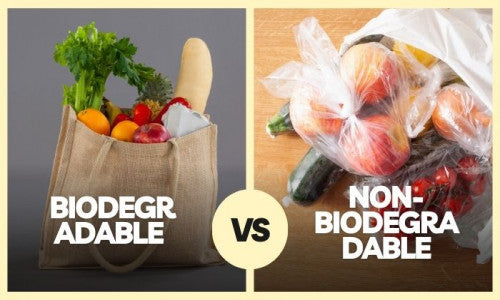Naturally or artificially, we produce waste on a daily basis. It can be either biodegradable or non-biodegradable.
This means living organisms can break them. While living organisms can’t break down non-biodegradable waste.
Biodegradable waste is an essential component of the natural cycle. When biodegradable waste breaks down, it releases nutrients back into the soil.
Non-biodegradable waste does not break down. It can accumulate in the environment and cause pollution.
For example, plastic bags can take hundreds of years to break down. This means they can end up in our oceans, harming marine life.
Here I will discuss the difference between textiles’ biodegradable and non-biodegradable.
Let’s get into it.
Biodegradable vs Degradable Fabric: Let’s get to the nuances
Before that, let’s get to know what is meant by "biodegradable fabric and degradable material”.
Biodegradable
When you hear something being degradable, it means it breaks down and decomposes naturally. Also, while decomposing, it leaves no harmful substance in the soil. However, it's a complete breakdown.
Living organisms can break down biodegradable materials. Up until they are no longer discernible, they can be divided into ever-smaller pieces.
Examples: food scraps, paper, and wood.
Non-biodegradable
Living organisms can’t break down non-biodegradable materials.
They can persist in the environment for many years, even hundreds or thousands. Plastic, glass, and metal are non-biodegradable materials.
Non-biodegradable materials are bad for the environment. They contribute to pollution.
Natural substances like carbon dioxide and water are released into the air as biodegradables break down. Non-biodegradable materials unleash toxic pollutants into our surroundings.
Fabric
So, when it comes to fabric, it's also the same. Fabric made from biodegradable fiber is a biodegradable fabric.
Some of the biodegradable fibers are-
- Organic cotton
- Linen
- Hemp
- Jute
- Tencel
Fabric made from these fibers is naturally compostable and eco-friendly.
On the contrary, a fabric made from synthetic fiber (for example, polyester) doesn’t compost in the soil. Over time, it might degrade but not decompose.
What does "compostable” means?
There's another term called compostable. Compostable means materials or particles will be fully absorbed by the soil. Also, after the composition, no harmful residue will remain.
So, degradable items don’t compost in the soil. However, biodegradable items compost naturally and fully.
Degradable Bags vs Biodegradable Bags
Both bags made from biodegradable and degradable materials degrade over time.
Degradable bags are made from materials that can be broken down by physical or chemical means.
This can happen through exposure to sunlight, heat, or water. However, degradable bags do not necessarily break down into harmless substances. In some cases, they may break down into small pieces of plastic that can pollute the environment.
Biodegradable bags are made from materials that can be broken down by living organisms, such as bacteria and fungi.
This process is called biodegradation. Biodegradable bags are typically made from natural materials, such as cornstarch or sugarcane.
Check availability of biodegradable bags here
When biodegradable bags are composted, they break down into harmless substances, such as carbon dioxide, water, and biomass.
In general, biodegradable bags are more environmentally friendly than degradable bags.
However, it is important to note that not all biodegradable bags are created equal.
Some biodegradable bags may contain additives that make them more difficult to biodegrade.
Wrap Up
Understanding the difference between biodegradable and non-biodegradable materials is vital for our environment.
Biodegradable materials break down naturally. It reduces waste and pollution.
They offer a sustainable alternative to long-lasting non-biodegradable materials.
Choosing biodegradable products helps preserve ecosystems and lessen landfill impact.
Remember, not all "biodegradable" products are the same; look for reliable certifications.
Frequently Asked Questions
1. What are biodegradable and non-biodegradable polymers?
Biodegradable polymers can naturally break down through microbial or enzymatic activity. They are designed to be environmentally friendly. They also reduce the impact of plastic waste.
2. Are clothes biodegradable or non-biodegradable?
Cloth can be either biodegradable or non-biodegradable, depending on the type of fabric.
Natural fibers like cotton, silk, and wool are generally biodegradable, as they are derived from organic sources and can decompose over time.
However, synthetic fabrics like polyester, nylon, and acrylic are non-biodegradable, as they are made from petroleum-based materials that do not easily break down in the environment.






